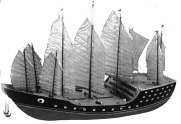 | In 1402, after Emperor Cheng Zu of the Ming Dynasty (1368-1644) ascended the throne, he dispatched Zheng He and Wang Jinghong to lead a giant fleet to the Western Sea (today's Southeast Asia), carrying members of soldiers and large quantity of goods. The fleet reached the countries of Southeast Asia, east Africa and Arabia, initiating a feat in the history of navigation and regarded as an unprecedented great historical period in Chinese history of trade and cultural exchanges. |
From 1405 to 1433, Zheng He led his fleet to voyage to the Western Sea for seven times. The number of ships of his fleet was from 40 to 63 each time, taking many soldiers and sailors on the voyage, with a total party over 27,000 people. Their ships navigated the wide sea area from Ryukyu Islands, the Philippine Islands and Maluku Sea to the Mozambican Channel and the costal areas of South Africa, developing mutual trade, exchanging culture and technologies, communicating traffic on the sea and promoting social and economic development in such countries and areas. The mighty fleet voyaged on the Indian Ocean, not only astonishing the Arabian navigators, but also amazing the Venice businessmen coming and going between Hormuz and Aden, hence providing a new enlightenment to the European navigation. Zheng He's voyages are 87 years earlier than that of Columbus, 93 years earlier than that of Gama, and 116 years earlier than that of Magellan.
|